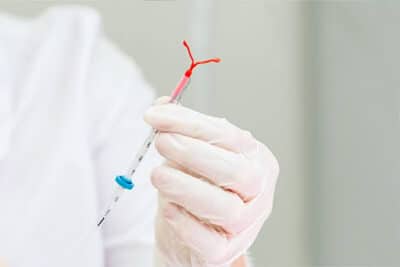Published on May 3rd, 2024 and Updated on October 18th, 2024
Check out SneakPeek Gender Test to find out your baby’s gender as early as 6 weeks with over 99% accuracy!

This article is not intended to be medical guidance. Please consult with your healthcare provider for personalized advice.
The time has arrived: Your trustworthy IUD—or intrauterine device—has reached its expiration date, and you’re due for a replacement. Or perhaps you’re weighing the idea of getting an IUD in the first place and are imagining its trajectory. Or maybe you’re ready to toss “the coil” completely and—hooray!—start trying for a baby.
Whatever the case may be, getting IUD removed isn’t nearly as wince-inducing as some might suggest. It’s true that every cervix reacts differently, but experts across the board insist that an IUD removal is a swift and safe procedure—and substantially less painful than its insertion.
We’ll leave you to make that judgment call. In the meantime, we have the intel you need so that you can walk into your IUD removal appointment mentally and physically prepped—and walk out primed for life’s next adventure.
The IUD Removal Process
First things first: How, exactly, is an IUD removed?
This may call for a quick refresher. An IUD is a small, pliant, T-shaped piece of material whose exclusive job is to prevent pregnancy. Depending on the type of IUD you opt or opted for, it aims to prevent conception by either:
- Releasing progestin—or synthetic progesterone—which halts the release of eggs and thickens your cervical mucus to fend off sperm from entering your uterus, or
- Triggering an inflammatory response in your uterus through the use of copper, which creates a less-than-welcoming environment for eggs and sperm, and prevents implantation
Both hormonal and copper IUDs feature strings that are used for two primary reasons: to ensure your IUD remains in place throughout its lifecycle (your doctor may have recommended checking your strings once a month) and to remove it—by a trained professional, that is.
Taking Out the IUD: What to Expect During the Procedure
Recognizing what’s going on down south while your feet are in stirrups is one of the keys to a stress-free (or at least stress-less) experience. Typically—and thankfully—getting an IUD removed is as straightforward as its insertion:
- Your healthcare provider will insert a speculum into your vagina to widen its opening and locate your cervix, and the IUD’s strings.
- Using forceps, your provider will gently pull on the strings to urge out the IUD.
- The device’s arms will fold up as it slides through your cervix and out of your vagina.
Complications can arise—more on this in a bit—but many women report only minimal cramping and compare it to the discomfort and tenderness felt during a routine pelvic exam.
How long does an IUD removal take?
All that said, an IUD removal requires only a few minutes—about as long as it takes to have your vitals checked.
In some instances, though, your doctor may have to rely on an ultrasound to locate missing strings and/or use an IUD hook to attach to strings that may have shifted into your uterus or cervical canal. If this isn’t viable (meaning those strings are still MIA), your doctor may conduct a hysteroscopy—a procedure that enables them to peer inside your cervix and uterus and continue with the IUD removal and ensure patient safety.
In rarer cases, IUDs must be removed surgically—generally, if uterine perforation has been inflicted by the device.
Immediate Aftercare and Recovery
The magic of modern medicine is that you can resume life as usual immediately after a standard, non-surgical IUD removal. This isn’t to suggest you should schedule a half-marathon for later that same day, but, aside from moderate to mild cramping (remember: pain is subjective), you might find an IUD extraction no more bothersome than a run-of-the-mill period.
That said, it’s vital to cue into your body’s clues—a topic we’ll turn to next.
Potential Side Effects and How to Manage Them
In addition to cramping and the sharp pang you might feel as your IUD is pulled out, you may experience light bleeding and dizziness. Spotting and cramps may, alas, persist for several hours to several days, but they can be mitigated with the basics of self-care (chocolate is optional) and OTC pain relief.
Less common symptoms that require medical attention include:
- Excessive or heavy bleeding
- Blood clots
- Severe abdominal pain
- Fever
- Vomiting
If you experience any of these side effects, be sure to reach out to your healthcare provider immediately.
Preparing for Your IUD Removal
While an IUD removal doesn’t necessarily require advanced planning—you can have it extracted at any time, and for a variety of reasons—there are several precautions you may want to take to keep cramping at bay:
- Eye your cycle – Removing your IUD can be performed at any point throughout your cycle, but you may want to schedule your appointment when you know you’ll be menstruating. Why? Your period may facilitate the removal process because your cervix widens during this time to shed menstrual blood and uterine tissue.
- Preempt the potential of pain – Physicians recommend popping an over-the-counter pain medication—such as ibuprofen or acetaminophen—30 minutes to 2 hours before your procedure, especially if you experienced significant cramping when you had your IUD inserted insertion.
Additionally, if you’re not on a mission to become pregnant and are asking “can you get pregnant while on birth control?”, you may want to avoid sex the week before your appointment: Notoriously stubborn sperm may survive in your uterus and vagina for up to five days.
Post-Removal Care and Monitoring
For some women, an IUD removal is as unmemorable as the set-it-and-forget-it nature of the contraception device itself, while those who experienced adverse reactions to their IUD might feel a sense of instantaneous relief.
Others who used a hormonal IUD, however, may go through hormonal changes not unlike starting and stopping oral contraceptives. Dubbed by some as the “Mirena crash” (for those who specifically used Mirena), these shifts may be accompanied by:
- Breast tenderness
- Acne
- Weight changes
- Mood swings
- Fatigue
If these sound familiar, you may want to book an appointment with your provider, who can assess you for a hormonal imbalance—and potentially provide you with medical advice for ways to curtail your symptoms.
Track Your Cycle After Your IUD Removal
If you went the copper route, your periods may return to normal almost immediately after your IUD removal.
For those who used a hormonal IUD, your menstrual cycle ought to normalize—however you might define it—within 3 months after it’s been removed. This may mean one of two things if you’re sexually active: a) you might select another birth control method, or b) you’ve decided to—cue the excited applause—try for a little one!
In either case, even irregular periods indicate you may be ovulating—and you might want to track where you stand in your cycle. To do so:
- Befriend your basal body temperature – Your basal body temperature (or BBT) is, put simply, your temperature when you’re at rest. Usually, it hovers between 97 and 97.5 degrees but it rises sharply when you’re ovulating, rendering it a wise time to either use contraception or, well, close the curtains. Because the vacillations in your BBT are detected down to 1/10th of a degree, your best bet is to invest in a basal thermometer.
- Monitor your cervical mucus – While hormonal IUDs purposefully thicken cervical mucus to thwart sperm from swimming north (so to speak), its natural texture paves the way for pregnancy. As your window of fertility nears, you may find that your cervical mucus is thin and slippery—which, again, might determine your course of action.
How soon can you conceive after an IUD removal?
One of the primary reasons women choose an IUD is because fertility may return straightaway after a copper IUD has been removed, and roughly within a month after a hormonal IUD has been extracted.
And yet, if you’re eager to conceive, it’s crucial to keep in mind that a whole host of factors can influence when and if you might become pregnant post-IUD removal. Age, body weight, uterine and cervical conditions like polyps and fibroids, and thyroid complications can all affect the answer to “when are you the most fertile”.
This underscores the importance of finding an honest, compassionate ally in an OBGYN—to remove your IUD safely (and, fingers crossed, painlessly), as well as to support you throughout your fertility and sexual journey.
Nourish Your Fertility Voyage with SneakPeek®
Having your IUD removed may be as minor to you as swapping out or getting off birth control options—or it could represent a monumental step on your potential path toward parenthood. If you fall into the latter category, SneakPeek® can provide you with another form of intel: Your future sweet pea’s gender.
Consider the SneakPeek® Early Gender DNA Test the real gender reveal. Through a sample taken from the comfort of your home, SneakPeek can tell you the predicted sex of your little one with over 99% clinically proven accuracy—and as early as 6 weeks into your pregnancy.
SneakPeek is the only patented baby sex test, ensuring reliable and accurate results that you can trust. When the time arrives, join the more than 1 million parents who have trusted SneakPeek with one of the most thrilling parts of their pregnancies. Because, planner that you are, don’t you want to be ready?
Editorial Policy
At SneakPeek, our commitment is to provide accurate, up-to-date, and reliable information to empower our readers. Our content is thoroughly researched, reviewed by medical experts, and fact-checked to ensure its credibility. We prioritize the well-being and education of our readers, and our editorial policy adheres to the highest standards of integrity and accuracy in all our articles.
This post has been reviewed for accuracy by the following medical professional:
Katie Smith is a seasoned Certified Nurse Midwife and a nurturing mother to six children, offering a unique blend of professional expertise and personal experience. She is the founder of Birth Your Way Midwifery and Women’s Wellness Center in Bay County, Florida. Katie's comprehensive approach to care is informed by her hands-on experience in motherhood and her passion for empowering women through their birthing journey. Her dedication extends beyond her center as she actively engages in community wellness and family health education.
Sources:
- Cleveland Clinic. Intrauterine device (IUD). https://my.clevelandclinic.org/health/treatments/24441-intrauterine-device-iud
- Women’s Health. Doctor’s warn women not to try viral DIY IUD removal TikTok trend.
- https://www.womenshealthmag.com/health/a37693710/iud-removal-tiktok/
- Kaiser Permanente. Hormonal IUD: birth control.
- https://healthy.kaiserpermanente.org/health-wellness/birth-control/types/hormonal-iud
- Mayo Clinic. Copper IUD (ParaGard).
- https://www.mayoclinic.org/tests-procedures/paragard/about/pac-20391270
- Healthline. Cervix before period: how to identify changes throughout your menstrual cycle.
- https://www.healthline.com/health/cervix-before-period
- University of Michigan Health. Intrauterine device (IUD) removal.
- https://www.uofmhealth.org/health-library/abp4777
- Healthline. What symptoms can I expect after removing Mirena?
- https://www.healthline.com/health/womens-health/symptoms-after-mirena-removal#symptoms
- Healthline. Getting pregnant with irregular periods: what to expect.
- https://www.healthline.com/health/pregnancy/irregular-periods-and-pregnancy
- StatPearls. Physiology, ovulation and basal body temperature.
- https://www.ncbi.nlm.nih.gov/books/NBK546686/
- Cleveland Clinic. Cervical mucus.
- https://my.clevelandclinic.org/health/body/21957-cervical-mucus
- Mayo Clinic. Getting pregnant.
- https://www.mayoclinic.org/healthy-lifestyle/getting-pregnant/in-depth/female-fertility/art-20045887.
- Tzu Chi Medical Journal. Role of hypothyroidism and associated pathways in pregnancy and infertility: clinical insights.
- https://www.ncbi.nlm.nih.gov/pmc/articles/PMC7605301/.
- Planned Parenthood. How does IUD removal work? https://www.plannedparenthood.org/learn/birth-control/iud/how-does-iud-removal-work







